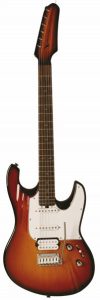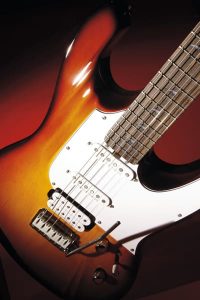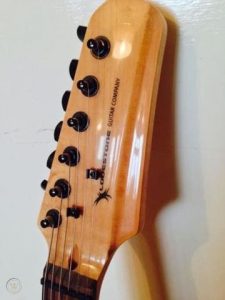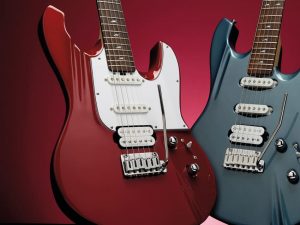If rock is about non-conformism, why do so many guitars look the same? At least one company is aiming to sculpt some new contours in the landscape. Review: Lodestone Electric Pro S Rick Batey
Lodestone Electric Pro S Review
Table of Contents
Lodestone’s Electric Pro SBuilt in Czechoslovakia but designed in Britain, the Lodestone Electric Pro S aims to update or even redefine a well-trodden path with some unique design elements, carefully-selected quality hardware and up-to-date materials. Other Lodestone models include the exotic-topped Electro Artist and the Electric Artist S, plus two basses, the Primal Pro and the Primal Artist. The ‘S’ suffix indicates that this is the slightly more traditional, carrying a modernised take on the T-style scratchplate.

The Lodestone is crammed with visual hooks but its standout feature is the ‘Laidback’ headstock, a design that presents the tuners to the player at a roughly 45-degree backwards angle (and if it seems familiar, it’s probably because you spotted it on the late-’90s Trace Elliot-distributed T-Bass, the brainchild of Mark Gooday, now of Ashdown amps, the folks behind Lodestone).
Regular-angle tuners have always felt just fine to us, so in ergonomic terms we would venture that the Laidback headstock is perhaps a solution to a problem that, for the vast majority of players, doesn’t exist. In addition, the upper back edge of the head tends to make contact with the thumb, which is a little off-putting. You can’t deny that the head presents a beautifully sleek, carved face to the audience, but the player only sees an unnaturally large and oddly-shaped peghead with a freakishly deep volute, and that takes a fair amount of getting used to. On the positive side the strings leave the Gotoh Magnum locking tuners at healthy angles, the string path over the nut is perfectly straight, and there are no string-trees to cause potential tuning hang-ups.
Design
The body is just as individual. Built from two pieces of alder, it’s an offset double-cutaway shape with a stylishly lopped-off top horn and a complex contoured top that smoothly integrates a forearm cut, a rear tummy tuck and a recessed control area. There’s also a contoured heel which accommodates four recessed bolts and allows decent access to all 22 frets. There are two chamfered sections on the inside of the horns and two ‘fluted’ sections, one above the scratchplate and one zooming downwards, away from the controls. These trademark body ripples must make the finishing process considerably trickier but the Lodestone’s polyurethane coating is glossy and immaculate, even in the most complicated areas.

The neck is maple, and whether it’s coincidence or not, we like the way it’s been cut not on the quarter nor on the slab but on a diagonal so that the grain follows the ‘kink’ in the Laidback headstock. The fingerboard is rosewood sprinkled with little eight-pointed pearl position makers. Though the factory set-up is admirably sleek with a low, low action and just a hint of neck relief, the frets are small – too low, perhaps, to attain bluesy string-bending heaven and a little too narrow to please high-gain speed freaks. The neck profile is refreshing, though. A hand-filling vintage ‘U’ with plenty of meat in the shoulders and a very likeable satin finish.
Lodestone Electric Pro S Features
The pickups are Seymour Duncans, two flat-pole ‘vintage voiced’ scratchplate-mounted SSL-2 single coils. And a screwed-into-the-body SH-1B ’59, a popular PAF-style all-rounder. These are linked to a master volume and tone with knurled metal knobs: opening the control cavity’s shielded lid we find that both pots are 500k mini-types. There’s also a fully-enclosed edge-mounted output jack and an enclosed five-way selector switch.Lodestone’s Electric Pro S
The bridge is a Gotoh 510 two-point floating vibrato, the same unit that you’ll find on high-end guitars from Grosh, Suhr, and others. It’s unique in that the strings (which here are D’Addario XL .009″s) mount deep inside the vibrato block, and only touch down at the ball-end and at the break-point of the saddle. The arm has a threaded internal bore, and comes with a locking collar to stiffen the downwards swing. Try as we might we couldn’t dial out a faint ‘click’ in the arm’s action. So a push-in Delrin-sleeved arm as on a PRS might be an improvement. The vibrato is light and positive with three of the possible five springs in place. And displays plenty of downwards bend but regrettably little in the way of upwards movement. Return to pitch is excellent.
Finally, the Electric Pro S comes armed with white ceramic bridge saddles (the metal ones are in the case). These, says Lodestone, ‘enhance clarity, dynamics, harmonic content and sustain’. And yes, acoustically this guitar is on the zingy side as opposed to warm and woody.
Sounds
Click the selector down to position 1 and you get the SH-1B humbucker alone. It’s bright and articulate and vintage in a crisp kind of way. And with an amp on the verge of crunch it cleans up nicely from the volume control with little loss of highs. Position 2 combines the middle pickup with the inside coil of the humbucker in parallel. It’s a softer sound without the humbucker’s output or middly high-end ring but with plenty of pluckiness for snappy Knopflerisms.
Lodestone’s instructions says that position 3 gives the middle pickup and both coils of the humbucker in parallel. It doesn’t – it’s just the middle pickup alone. It’s a sweet and useable sound if perhaps not a real stand-out. As is often the case with a traditional Fender Strat. Position 4 is the regular neck and middle, poppy and contemporary and a touch darker than position 2, while position 5. The neck pickup alone, is our second favourite setting next to the humbucker. With a smooth finish and a welcome dollop of warmth and depth.
Verdict
For the way that Lodestone has overlaid a modern rock guitar with that almost art nouveau body fluting we must offer a ripple (oh, please) of applause. The headstock? Mixed feelings here: we can’t complain about its functionality or handsome looks from the front. But the back-angled tuners don’t really speed up tuning for us. Bear in mind, too, that this is not a vintage-voiced guitar. There’s an ever-present silvery sparkle that parks it firmly in the contemporary section. Although re-fitting the metal bridge saddles may help turn back the clock. The neck is highly playable, though, and we can find no fault with the woodwork, finishing or hardware. At a price which usually confines us to the low/mid end of US-built guitar ranges. The Lodestone offers a new, surprising flavour.



Leave a Reply
You must be logged in to post a comment.